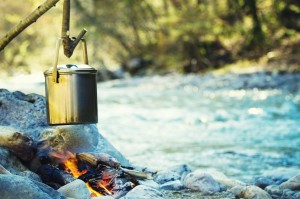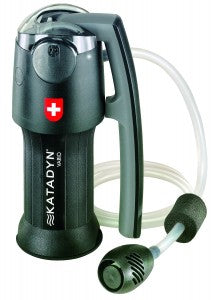
Water is so vital to our lives and well-being that it’s a number-one concern during emergency situations. It's even more important than food for the first few days when dehydration could set in and cause illness, confusion, and even death.
You may know this and have emergency water storage. But maybe you have some old stored water that has a strange odor to it—or maybe you aren’t sure that your city’s water supply is really clean. You may have to get your water from an untested source such as a private well or spring, or bring water from a lake or river into your home during an emergency.
So what are the dangers of drinking untreated water and how can you be sure it’s safe?
What could be in the water?
Out hiking or camping, we may come across a cold, running stream with clear, sweet water; it’s safe to drink, isn’t it? Well, it may be—or not. We can’t always see, taste, or smell the tiny pollutants that may be present. There could be anything in the water, from mud and chemicals to animal waste and decomposed matter to microorganisms like viruses, harmful bacteria and protozoans. Many a camper has brought home Giardia as a souvenir from a camping trip, and suffered from the severe digestive upset that results. So how can we avoid getting sick from questionable water sources? There are several ways to filter and purify water that can give you peace of mind about the sources you have access to at any given time.
Boiling
Often when a community water supply has been compromised, officials will issue a “boil order,” advising everyone to boil water (a full, rolling boil) for at least one minute before using it to drink, cook, wash dishes, wash the face, or brush teeth. Boiling water from a natural source is effective, too, killing both bacteria and viruses. (This can take longer in high elevations where water boils at a lower temperature.) If you don’t have gas or electricity, either in an emergency or on a camping trip, the boiling can be done over an open fire, on a grill, with a
Kelly Kettle, or even in a solar oven set in bright sunlight for six hours.
Filtration
There are
filters and then there are
microfilters—and it’s important that you know the difference. A regular filter blocks the larger (but still tiny) impurities in water, improving the taste and color—but a microfilter can block both impurities and microorganisms that cause illness.

Filters are commonly made of three materials:
-
Ceramic—filters out impurities of 0.2 microns or larger
-
Pleated glassfiber—filters out impurities of 0.3 microns or larger
-
Activated carbon (or charcoal)—which filters out impurities of up to 2 microns.
For perspective, consider that a human hair has a diameter of about 100 microns, so we’re talking really tiny (but powerful) particles!
Purification
There are two basic methods of purifying water—
UV Purification and
Chemical Purification.
-
UV Purification works by killing the microorganisms with shortwave germicidal ultraviolet light. This light (invisible to us) works by disrupting the DNA of the little pests so that they can’t cause illness. UV purifies 99.9% of all microorganisms in just seconds. See our Steripen™ Ultra purifier and our Steripen™ Sidewinder purifier for a couple of great purification options.
-
Chemical purification also kills 99.9% of microorganisms, but it takes a while longer—about four hours. Chlorine Dioxide is the preferred chemical for water purification. Pure chlorine does not kill Cryptosporidium in amounts that would allow the water to be drinkable, nor does iodine, as the Crypto organism is iodine-resistant—but Chlorine Dioxide takes care of it, and improves the taste of the water. (Iodine, even if it worked, would give the water a foul taste.)
What are the specific microorganisms to worry about, and what works to get rid of them?
-
Viruses (Hepatitis A, Norwalk, Rotavirus) are the smallest particles to worry about (.018 microns); they need purification, not just filtration. They are less common in U.S. natural water sources than in other parts of the world, but they can exist here.
-
Bacteria are .5 microns and up, and include such “bugs” as E. Coli, Salmonella, and Campylobacter. Either microfiltration or purification is effective in getting rid of these.
-
Protozoans range from 2 to 15 microns and include Giardia and Cryptosporidium. Both filtration and purification are useful against these. The EPA reports that 95% of the world’s natural water supply contains protozoan cysts.
-
Turbidity is the name for “gunk” in the water—floaties, waste, insect, dirt, silt, and chemicals. These affect the taste and the drinkability of the water. Filtration is the method to remove the first five, and activated carbon can remove some chemicals, but not all—so that it’s always important to Replace the cleanest source of water you can before treating it.
Not only is it important for you to store good, clean water, but also to know how to and have the means to filter or purify the water you have at your disposal at any given time, be it from your tap or from a natural source such as a river or spring. Learn more about water filtration and storage in our
Water Storage Insight Articles.
Sources:
www.beprepared.com
www.water.epa.gov/drink/emergency/safe_water/personal.html
www.cdc.gov/travel/page/water-disinfection



8 comments
Penelope Smith
I liked that you pointed out that you should make sure that your water is being filtered for protozoans. That seems like a good thing to consider when you need to get a filter. Also, it might be smart to think about the amount of water it can filter as well. https://www.filterforfridge.com/product-category/mwf-filters/
andyg
Clear containers (like the plastic water bottles and gallon jugs) will allow microbes to grow after sitting on a shelf for a while, it would be best to treat or filter it. Products like this work well.
Wd
What about buying water gallons from the grocery store? If they are never opened can they be used after a few years? Do they need boiling?? Are they just trash??
Thank you
blubag1
I would advise against it. Windshield solvent is toxic and can react with household cleaners, even something as edible as vinegar creating a bigger problem than you started with.
JOYCE BLAZER
I HAVE A BLUE 55 GALLONS BARREL THAT HAD WINDSHIELD WASHER FLUID IN IT , HOW DO I PROPERLY CLEAN IT & BE SAFE ABOUT IT ? THANK YOU VERY MUCH FOR “ALL” YOUR HELP & WEALTH OF INFORMATION THAT YOU SHARE. MAY GOD BLESS Y’ALL. JOYCE
beprepared
Hi, Southern Patriot!
Typically with the bleach, it should be okay—especially if, when you open the barrels, you get any bleach smell. However, it also depends on the storage conditions. Were the barrels in the sun? Indoor/outdoor?
Let me know some more details, and I’ll have our experts weigh in on the specifics.
Sarah
Randy
Boiling and filtering is fine for some water; however, as in the recent case of contamination (Algae toxins) in the water supply off Toledo, Ohio (Lake Erie), boiling made the water contamination more concentrated and normal filters would not work. Short of expensive military and government equipment not available to the civilian population, How would I and my family get safe drinking water from toxins produced by things like algae?
Southern Patriot
I have a question about storing water, Several 55-gallons barrels of water have been in storage for about 2 years. Bleach added prior to filling and capping off. Is this water any good? Should it be dumped or could this be used after boiling for 3-5-10 minutes? Thank you Southern Patriot